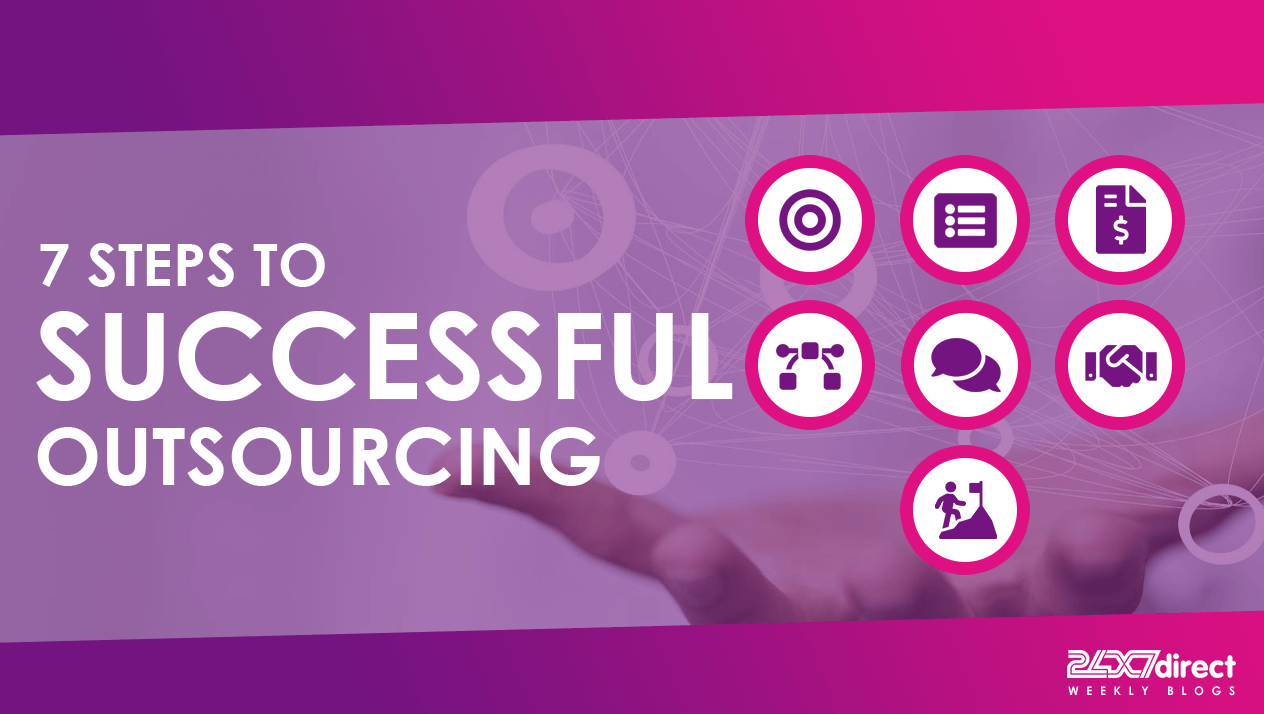Gone are the days when business owners and managers established huge buildings and carried all business processes in-house. Since today, we believe in the philosophy of ‘customer is the king,’ business organizations are also on the lookout for doing quality work at an affordable rate. Thanks to globalization and the widespread use of the Internet, the resource market is no longer limited to the geographical boundaries of a country. Nowadays, a company can have headquarters in United States, carry out production in China, and manage customer care services from India. All these developments come under the term ‘7 steps to successful outsourcing.’
What is Outsourcing?
Essentially, successful outsourcing is a practice where companies contract out some of their tasks and operations to third parties that specialize in the same. Outsourcing has two types — offshore outsourcing and onshore outsourcing. While offshore outsourcing refers to hiring service providers in far-away countries operating in different time zones, onshore outsourcing involves contracting out tasks within the same country. Some common services include; information technology services, customer care services, manufacturing processes, and so on.
The primary reason behind the popularity of outsourcing is that it allows the senior staff of a company to focus on more pressing issues by assigning routine tasks to third parties. It also helps them in freeing up personal resources for other purposes and reduces both operational and employment costs. At the same time, companies can easily benefit from the global talent and world-class capabilities. In short, it saves their time, costs and also ensures high quality work.
Outsourcing does sound like a win-win situation, right? Although it comes with many benefits, very few companies successfully manage to reap them. This is because outsourcing has a significant impact on the overall functioning and the organization of business houses. It surely helps them grow and diversify, but it can also lead to ugly disputes and heavy losses if not taken care of properly.
Here are the 7 steps to successful outsourcing that will help you in planning and managing your outsourcing services efficiently.
7 Steps to Successful Outsourcing
1. Define the objectives of outsourcing:
Before going for a successful outsourcing, ask yourself why do you need to outsource? What do you seek to achieve through outsourcing your activities? As mentioned before, outsourcing include a variety of reasons. Some of them are:
- Reduce costs
- Leverage global skills
- Get access to innovations and technologies
- Concentrate internal resources in other activities
- Mitigate risks
- Expand in other areas
- Increase the quality of product or service
Expressing the goals of outsourcing clearly helps all the parties involved in framing the contract. It also avoids misunderstandings and conflicts at a later stage. The biggest advantage of defining the objectives is that everybody sets the same expectations with the deal. This results in better decision-making and smoother communication.
Since the decision for outsourcing can have a huge impact on a company, it is advisable to discuss the entire idea with your managerial team. Different people can come with different suggestions, which in turn can lead to more informed decisions. Once everybody gives their consent on the final draft, you are ready to proceed
2. Identify what needs to be outsourced
Now that you know what you want out of outsourcing, it is time to think about what activities should you outsource. In every small business, the managers and employees are busy performing various tasks such as planning, organizing, producing, marketing, supplying, after-sale services, and so on. On a general note, it is impossible for any company to be an expert in all these areas. There are always some departments that can operate more efficiently. Before we proceed to the 7 steps to successful outsourcing, you need to identify these activities.
Most companies outsource tasks associated with:
- Information Technology
- Infrastructure
- Security
- Customer Care
- Maintenance
- Telecommunications
- Software
- Research and Development
- Organizational Support
- Accounting
- Social Media Management
When considering what to outsource, you must differentiate between your company’s core activities and routine activities. Do not outsource tasks and processes that are key to your organization. Instead, you should contract out other activities that do not require constant vigilance and can be best carried out by others.
Another factor that can help you in making a better decision in this regard is an evaluation of the current infrastructure. Do a careful assessment of the present business performance, cost savings, internal and external capabilities, service performance, etc. If the loopholes found can be addressed by upgrading the current infrastructure effectively and efficiently, then you may not be in urgent need of outsourcing. But if the problems cannot be solved in-house, outsource them to agencies that specialize in the concerned areas.
3. Evaluate the costs of Outsourcing:
The benefits of outsourcing do not come for free. A lot of time and money goes into making this decision. For instance, you have to plan and design the contract for the procurement of services. You have to recruit, select, and hire people with the necessary skills to form your offshoring team. Cost is also incurred in educating the hired people about the company’s policies and training them. Even after the tasks are outsourced, you have to restructure the whole organization. Therefore, it is beneficial to evaluate the costs of outsourcing beforehand.
4. Understand the constraints, challenges, and advantages of outsourcing:
A successful outsourcing comes with its own set of constraints. It is advisable to think about and prepare for them in advance. Some of the barriers that you will have to take care of can be environmental problems, legal issues, country standards, labor laws, political issues, technological problems, and so forth. You can convert these challenges into opportunities by consulting your team and partners. You must understand where your core business stands and how well are its present associations working. If your organization or its processes change constantly over time, the risk in the outsourcing arrangement is higher and vice-versa.
5. Clearly communicate your expectations:
Effective communication both internally and externally is essential for successful outsourcing. All the stakeholders must be on the same page regarding the working and the outcomes of the contract. When you will clearly let the third parties know what you expect from the outsourcing industry, they might even help you in improving your operations. This is because they are experts in providing services. They know the nature of such contracts and their viability. Consequently, they can give good advice regarding legal, political, technological, and other matters.
At the same time, it is important for you to take care of the people working internally. The decision to outsource is huge and has a major impact on the entire company, its people, and operations. The employees may become insecure about their positions. Therefore, to avoid the spread of unnecessary rumors that may tarnish the company’s reputation, it is best to openly communicate with the people and keep them informed about the decision of the company..
6. Strike the deal with the right partner:
Once you have decided to outsource, you need to find the right partner. Since most offshore arrangements are long-term contracts, striking a business deal with the correct party is crucial. To maintain a long, happy, and beneficial relationship with a supplier, you must offer a deal from which both parties attain value. To do so, you first need to gather a mix of people who know the operations of the business and how negotiations are done. You must research the prospective suppliers, compare their service levels, costs, and reputation to identify the correct supplier for your company.
When you have found your supplier, frame contracts that are complete and explicit with some room for change. Express all the terms and conditions clearly. You can also mention the ethics and principles that will govern your association in the years to come. All these measures help in maintaining the business relationship for a long time.
7. Measure the performance:
Outsourcing is not a short-term project. On average most outsourcing contracts are applicable for three to five years. If the association remains healthy for all parties involved, the contract period can also be extended. But before extending the term of outsourcing contracts, you must evaluate whether you are getting the expected results or not. You must regularly measure the performance of your offshore operations, find gaps, and establish ways to fill them. Continuous training and education of employees are important. You must also upgrade current technologies and processes and always remain open to innovations.
Both onshore and offshore outsourcing can prove to be a game-changer for your business. But the decision to contract out tasks and processes is not such that it can be taken overnight. Thorough planning, clear vision, and open communication are crucial not only before building a deal with a service provider but also afterward. The steps mentioned above will help you in articulating why and how you can establish successful outsourcing relationships with third parties. It will act as a guide making you aware of the things you must avoid and factors you must consider before going ahead with this major decision.







